Distillation should of course be an option, but the question is what happens if one separates the ethanol from the fuel by adding water and then uses it as a fuel in a liquor stove or maybe in an alcohol heater? With the latter I mean one or more burners that are located indoors, which creates direct heat. A kind of poor man's stove, ie an extra supply of heat which is really a substitute instead of a fixed stove/fireplace. When methylated spirits are quite expensive seemed the idea not so clever, but the question is in a different light if one instead could use E85...
Such spirits heater is not news, because the method is available for purchase, if one thinks it's a good way to heat their houses with? A unique advantage of liquid-based fuels is that you can abolish the exhaust channel when the heat goes directly into the room (like a candle or tea light). The efficiency is therefore 100% for an open spirit burner and thus greater than for a stove and other heat boilers.
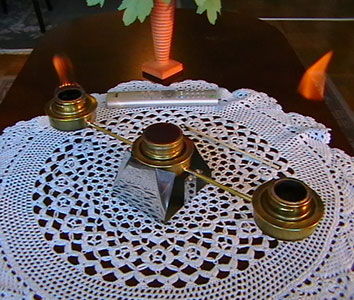
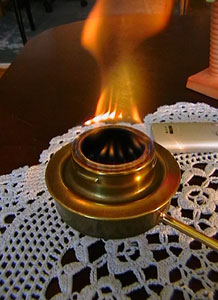
A home-built liquor heater which consists of three burners can look like this. They belong to the army; field kitchen (m/40) and is
paired with two brass tubes (brazed). These gadgets can be obtained cheaply at the army surplus stock.
That said, while E85 cost as it does now (2011), it might take some time before methylated spirits can compete away the E-sprite? It took a variety of experiments before an environmentally, friendly and cost effective method had appeared. It has been shown that in addition to water, it is necessary to have an easy-liquid heavy naphtha, or petroleum product such as; diesel, some lubricants, lighter fluid, kerosene or paraffin oil (lamp oil) - if the separation of gasoline and ethanol shall be effective. Petroleum and naphtha are different names for the same thing. Once you have measured everything (E85, naphtha and water) is it only to mix them thoroughly and then wait for the separation process will separate the alcohol from the gasoline. That which floats above ”the residue” consists mostly of gasoline with a hint of naphtha. Most of the naphtha is dissolved in the alcohol which then is a part of E-spirit. The residue is an energy-rich fuel and could be recycled as fuel. It is mostly gasoline laced with naphtha. In any case, the residue seemed to be very highly soluble in a variety of fuels (gasoline, diesel, E85 ...), so just pour it in your gas tank.
Contrary to what one might think burn E-spirits much like ordinary methylated spirit but without to decarbonizes, or cause a bad smell in the room the burning takes place. Only a faint smell of barbecue may be noted, even if you fire hard with multiple burners indoors, despite the fact that E-spirit contains both gasoline and naphtha - but in small quantities then. Today's diesel and lighter fluid is designed to ensure a good environment and then they burned without forming a lot of unnecessary waste. But yes, can you find a cheap party methylated spirit so is it probably preferable (in comparison with E-spirit).
One can for example using two five litre kegs. The preparation of E85 fuel, water and naphtha can be done in one of the kegs - the second keg is filled with ready E-spirit. I have previously proposed vacuum hoses but they swell up in E-spirit - however works PVC hoses in E-spirit. One start by pouring up four litre of E85. Then add 10 percent naphtha and 20 percent tap water. It becomes 400 ml naphtha and 800 ml of water. Together is this 5200 ml, but due to the shrinkage will it be 5000 ml (5 liters). Wait a few hours before the separation begins - through the hose by utilizing the siphon principle. Time is not directly critical here; 3-5 hours is about right.
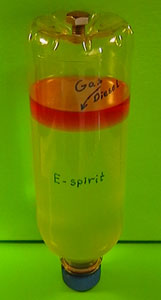 The stage when it is time to separate.
The stage when it is time to separate.
I have also experimented with 35% water in E85, but unfortunately smells this more gasoline and one have to prepare with acetone to avoid the smell of gasoline will be noticeable, but the naphtha-method removed on the other hand almost all gasoline. E-spirit contains besides ethanol; water, gasoline and naphtha, also denaturant and MTBE. It smells of deterrence and tastes probably not so good. Now I can not say with one hundred percent certainty that nothing harmful is produced during the incineration itself, but it is in any event nothing noticeable in the short term. The times I have felt the gasoline odor is quite unpleasant and then begins soon a headache as a consequence effect.
E-spirit with the naphtha-method
- Measure up an arbitrary amount E85
- Add 10% naphtha in the amount of E85
- Add 20% water in the amount of E85
- Separate the alcohol part after a few hours of phase separation (the residue can be recycled as fuel)
An alcohol analyzer (hydrometer) shows 86%.
The choice of naphtha is very important for the degree of coating as with time is formed inside an ordinary spirit burner (similar to a Trangia stove). After a long period of testing of different spirit burner fuels, has it been shown that naphtha that is soot-coating also causing a coating in the burner interior. This coating gives rise to smoke and clog the small holes that sit in a circle on the burner top. The smoke is formed only after the spirit burner goes out - the burner is very hot then. The unburned residue stay there and smoldering so that the indoor environments become poisoned. Continues a combustion with a soot-coating naphtha such as diesel or lighter fluid will the spirit burner become clogged, making it almost impossible to use it. The only way to clear a clogged burner from coatings is to heat it with a propane burner and so to speak, burning away these fuel residues - find a well-ventilated place before this happens!
To avoid the formation of coatings one can do two things. First and foremost you should choose naphtha that not soot and in that case it is only possible to use lamp oil or paraffin oil and nothing else. Kerosene is the second best naphtha product but is some soot-prone. Kerosene is not preferably intended to be used indoors, but is designed for outdoor use (kerosene lamps). Lamp oil / paraffin oil is for indoor lamps, but still has a tendency to cause poor air quality as time goes on.
Can one add any substance to minimize the residual soot? The answer seems to be affirmative on this point. I have tested various salts, fuels and oxidizers with no beneficial results. However, what worked was to add a tiny splash of red glycol in the resulting E-sprite. Note that you only can use red concentrated antifreeze, not the blue or green! Glycol remaining in the burner and seems to bind coatings. These can then be removed if one wash/rinse out the spirit burner with plain water, and why not with detergent? This is only necessary after a long period of use. What I have noticed is that the burner design that consists of several paired burner with pipe-connections, are less inclined to push, then the connection evens out pressure surges. Such cascade structures can be run with wider cleaning interval in comparison with a simple alcohol burner. The content of red glycol (longlife G30) is 1 ppt (0.1%) which is equal to 1 ml glycol per 1000 ml E-spirits.
Nowadays there is a last resort and that is to choose E-spirit+ instead of regular E-spirit, if the naphtha still is a scourge? A little more expensive but still cheaper than pure methylated spirits.
One can make a list of the best naphtha product at the top and the worst (most sooty) at the bottom:
- pure paraffin oil
- lamp oil
- lamp kerosene
- kerosene
- white spirit
- lighter fluid
- diesel
A content list (by volume):
- 68% ethanol
- 2% mtbe
- 8% naphtha
- 4% gasoline
- 17% water
- 1% denaturation
E-spirit has a density of 830 kg/cbm and the calorific value 25 MJ/kg. It is a substitute for methylated spirit and contains naphtha, which makes it feel fat/slippery in comparison with methylated spirits, thereto contain it water. It burns relatively safe and does not turn off by itself. Incinerates E-spirit in dedicated liquor burner formed no water but if one incinerate it in a bowl will the combustion become incomplete, with both water and soot as residues. The flame is yellow and sooty but cause no more trouble with the indoor environment than with tea lights. For methylated spirit is the calorific value 28.5 MJ/kg and is slightly better than E-spirits. For a certain amount of methylated spirit requires 10% larger amount of E-spirit for not the calorific value should diff. At a price comparison may one take 1.1 times methylated spirits (which gives the amount of E-spirit) and to get the amount of E85, one takes the amount of E-spirit and multiplies with 0.9. The amount of naphtha is 0.1 times the amount of E85. In 2011, costing E-spirit at about half of what methylated spirit costs (with lamp oil and without that the gasoline component is recycled).
E-sprite is not a good cleaning then the naphtha creates stains and because it contains water, it may stir up rust but then it contains naphtha, it may be vice versa? E-spirit may become cloudy if it allowed to stand and be attracted to water - can be counteracted by the addition of methylated spirits. The turbidity symptom is a sign that the naphtha slowly separates. If one pouring up E-spirits that are phase-separated, one gets a higher proportion of naphtha in the liquor burner than can be consumed and soot will be formed. This scenario can easily be avoided by shaking the can/keg with E-spirit before pouring. Another way is to add 5-10% industry spirit, methylated spirit, some other alcohol or acetone into the final rate of E-spirit - if you do not want to shake.
As a fuel in the stove is E-Spirit a questionable option but it should then be prepared with 15% naphtha and 15% water, instead of 10/20. This gives a slightly stronger but more cloudiness prone E-spirit: Hydrometer Value 90%, ethanol 72%, naphtha 9%, gasoline 3%, water 13%, density 820 kg/cbm, the calorific value is then 27 MJ/kg - in other respects the same as 10/20 variant. Avoid to use 15/15 for spirits heater indoors and is the intension to use it as a fuel for camping stoves, should it first be mixed with methanol. If one trying to make even stronger E-spirits, increases the content of the naphtha so much that it not have time to burn - with soot and smoke as a result of this.
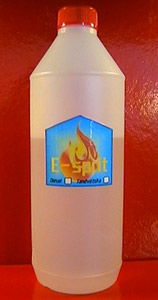
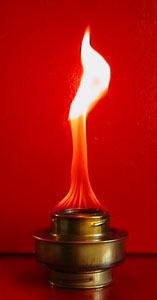 The right picture shows a spirit burner in action - model 40 loaded with E-spirit.
The right picture shows a spirit burner in action - model 40 loaded with E-spirit.
Adding water will shrink the total content. The amount of E-spirit can approximately be calculated from the available volume of E85:
Amount of E-spirit = 1.1 x E85
The separated spirit from the five-litre keg is approximately 1.1 x amount of E85, which was four litres; 4 x 1.1 = 4.4 litres - thus, it becomes 4.4 litre E-spirits. The amount of the residue is approximately 0.15 x amount of E85; 4 x 0.15 = 0.6 litres.
Perhaps one led to believe that higher alcohol levels can be obtained by simply adding (large amounts), extra gasoline in the phase separation-tank? Or will the spirit become more gas-free if extra gasoline is added? The answer to both questions is no. Regardless the gasoline content is not the content of gasoline in the alcohol solution (which shall be separated later) - less than about 5% (if one use the naphtha-method becomes the gasoline content lower). A large quantity of gasoline wills border up the fluids faster but it is the water versus the ethanol content which determines the gasoline content.
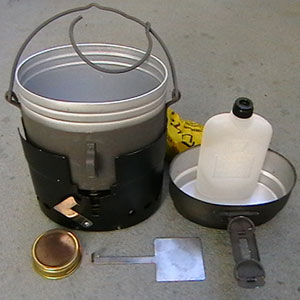
The army field kitchen (slightly modified here) can be used as a mobile camping stove during the holiday period. Quite substantial
affordable (35kr), in comparison with a new kitchen of the model Trangia.
Are you looking for an alcohol mixture for a liquor stove is there products such Tenol, ”stove fuel” etc. which actually generates soot, in spite of that they are optimized for use in a stove? The reason is that they must include a denaturant (safety rules), and the concentration of methanol can not exceed 10%. In view of the regulation of ethanol products, it is easy to be amazed by how expensive Tenol actually is when it still does not work. The idea is that people who do choose to drink Tenol - should not have to die or become blind. Sure is Tenol a highly effective alcohol fuel but when the soot forming an insulating surface at a cooking pot, the heat transfer is inhibited and a lot of energy is wasted.
Denaturing agent and the dye contributes of course to the soot but also distilled methylated spirit soot. According to Wikipedia shall pure ethanol not soot, ie burn with a blue flame as methanol does. However, also acetone soot even though it is ”chemically pure”. That would depend on additives that create a yellowish flame (visible flame). Is there any way (except distillation) to clean for example methylated spirits from that soot - would it surely be welcomed. A highly efficient and soot-free fuel would then be methylated spirits mixed with half methanol. Methanol is less energy rich than ethanol (22 MJ/kg), but only ethanol/methylated spirit burns almost too intense, so that the flames shooting out from the stove - in addition, it will be soot. With the half of methanol burns it moderately strong, with a blue flame (indicating high-energy radiation). I prefer Frosty's ”Stove fuel” and with methanol 50/50 as it is an anhydrous alcohol product (which is not denatured) - and free of dyes.
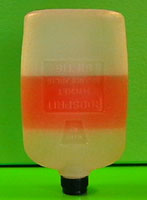
The bottle, which one should keep methylated spirits in are excellent if anything must be separated. Just unscrew the cap (not quite)
and then squeezing the bottle.
|
| |
|
| |


